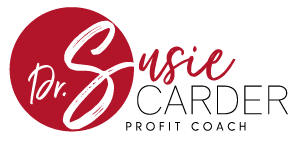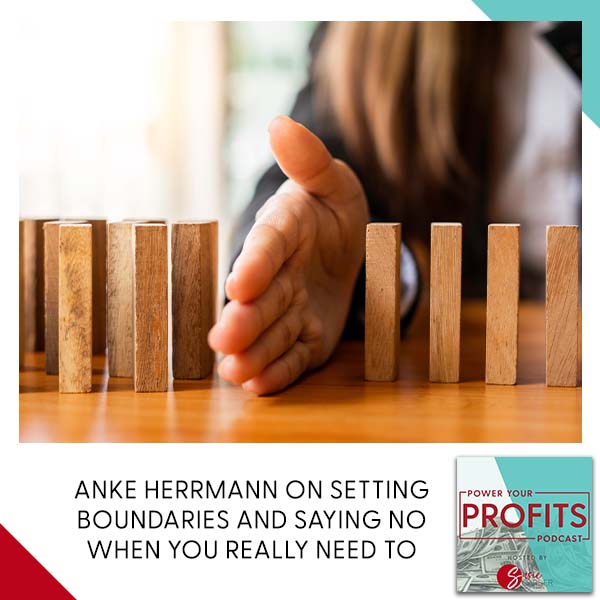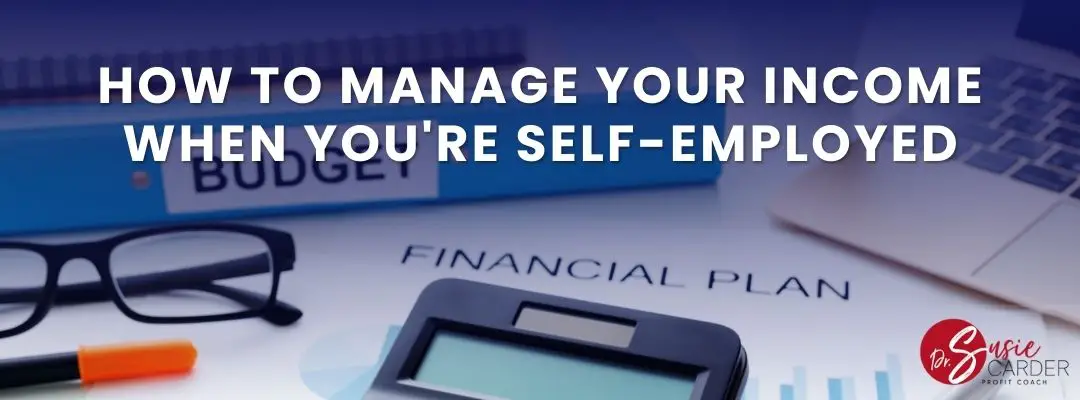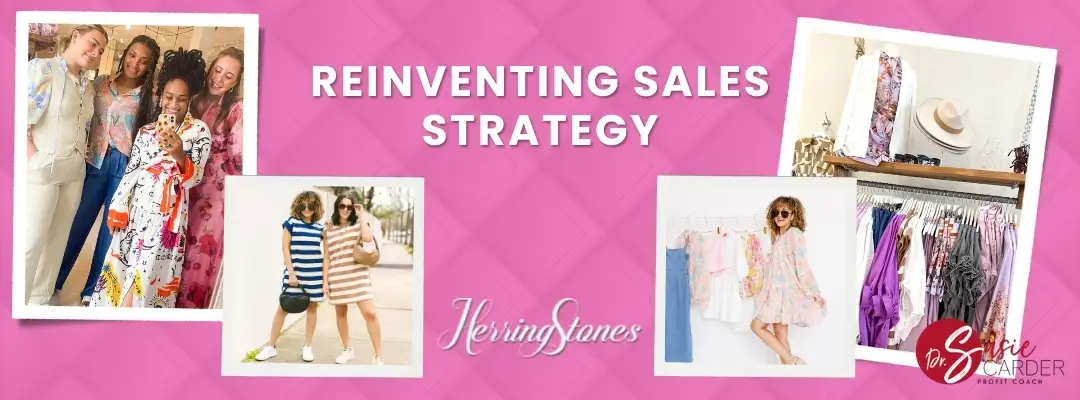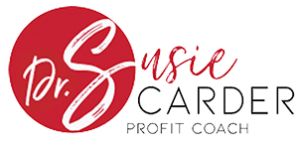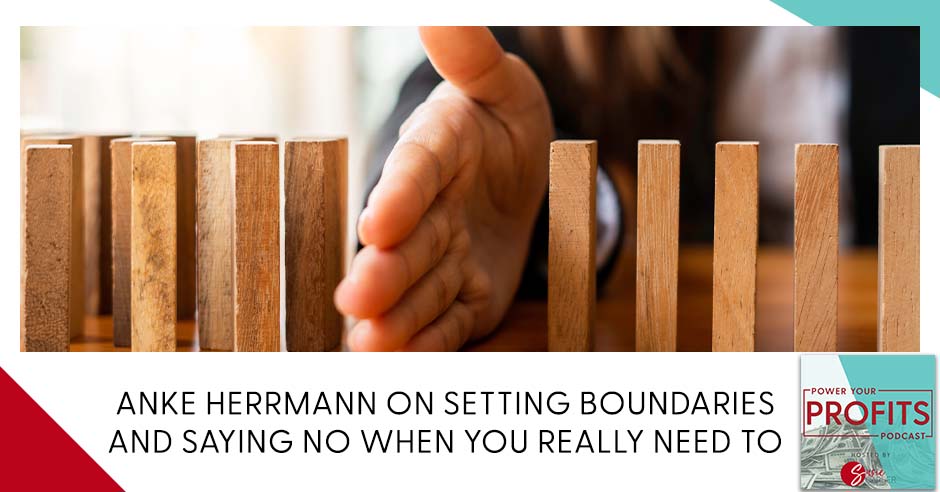
As an entrepreneur, you need to set boundaries. If your client asks you do something, know that it’s okay to say no. They won’t hate you for saying no. Service isn’t saying yes to everything people ask you to do. Join your host Susie Carder and her guest, Anke Herrmann, as they discuss the importance of setting boundaries as an entrepreneur. Anke is a business coach and an online tech mentor. Listen to her career journey of how she got burned out because she kept saying yes to everything. Also, learn about her new book, Taming the Tech Monster, and discover why you shouldn’t shy away from tech. Tune in to today’s episode to stop saying yes to everything today!
—
Watch the episode here
Listen to the podcast here
Anke Herrmann On Setting Boundaries And Saying No When You Really Need To
Welcome to the show. Our guest is Anke. She’s a business coach, more importantly, a tech expert, and the author of Taming the Tech Monster. She quit her software development job in the UK to start her own creative business in Spain. Now, she uses everything that she learned in business, tech, creativity, and psychology to help professional coaches build profitable online businesses. Please welcome my guest.
—
Welcome to another amazing episode, and do I have a surprise for you. I know I say that a lot, but you don’t even know. This woman is a powerhouse. She takes this scary out of our website and our technology. I don’t know. If I touch technology, I break it, so I love when I can surrender to my friends, and they can help us. You look at her tag. It’s coach, mentor, tech expert. Mine is a tech breaker. Please welcome, Anke. Thank you for being here. I appreciate you so much.
Thank you so much for having me. It’s exciting to be here.
Tell everyone, what is your magic? What is your secret sauce in the world?
I always call it an x-ray view when I look at visionary ideas. You know that thing you want to create, but you’re not quite sure how. You’ve just got that sensation of this icy fluid, and I can distill it down into the steps that you need to take one after the other to make it happen. My secret sauce is my weird mixture of background. My background is in Linguistics and Psychology. I started as a teacher and a translator, and then I stumbled into software development. When I first got my first pace of programming, my reaction was like, “This is like a real language, just simpler,” so I took to that.
For any project I’ve ever worked on, I was always the geeky person who could talk to clients. I’m the person who will not say to you, “Send me your content,” and then get upset because it comes late and people don’t know what to send. I consider that my job, and it’s the fun part to help people take an idea where they’re like, “I have this online business. I got this idea. I have this mission. This message that needs to come out into the world.”I don’t know where to get people signed up for something, so I bridged that gap that nobody talks about because anybody who teaches a strategy or anything, they’re always like, “There’s positioning in the marketing, and there’s a lot there that people can learn.” Then when it comes to making it happen, the first question people always ask is, “What platform do I need?” Then they sign up for some platform, or they get overwhelmed and don’t even know, and it ends there, or they end up rushing out, buying some stuff and anything that promises to take care of the tech for them.
Once they do that, the next thing they find are questions like, “Put your API key here,” and they go, “What?” There’s this huge gap in between where you have to take your idea and think it through at a level of detail that most creative visionaries don’t want to deal with, so that’s what I’m most comfortable to say. It’s to take an idea and bring it grounded into the earth to make that happen.
Your inner demons are going to get you if you don’t learn how to say no.
We get caught up in the sexy sales of it all. I had multiple software that did the same thing, but each one did one little different thing, so I had 4 or 5 of the same thing using these platforms, paying thousands of dollars because I didn’t know. What I love that you said is you do geek speak, but for the layperson. You’re not speaking geek to us. You’re just going, “No. Don’t do that. Do this,” which I love. Tell me what I don’t need and tell me what I do need, and then I’m all for that. That’s what I love about you. It’s your integrity and your high level of being responsible for people’s money to go, “This is a system that we need.”
Back in 1999, I launched my first technology business. Before Google and software share, I spent $500,000 on a website because we had to build it from scratch. Some people do overcharge for what they’re doing. I’ll look at some people’s websites, and I’m like, “How much did you pay for that?” That’s why I want people to meet you, because of your integrity.
Your commitment to helping people find the right solution in their budget, but with the level of expertise that you do it and simplicity that you don’t have to spend $500,000. Back in the day, there was no Infusionsoft and Stripe. There was none of that. We had to build it. There was no, “Good job. You’re teachable,” so I love that. That’s such a great story of where we’ve been to where we’ve come from in a short amount of time.
Many people are struggling now with the pandemic. I coach entrepreneurs and their stuck, so what has been your own secret sauce in your own business? I like to get the real skinny from you being a coach and then you being an entrepreneur because we sit in both seats. People think we’re not touched in this whole thing, but you had to reinvent your business and had to look at it differently. You had to go, “What am I going to do now?” You didn’t sit back and wait for this to get over with because it’s not getting over with. What have you been doing to stay ahead of that curve and to make sure that you’re staying in front of people and in people’s minds?
I’m probably not the first one to say this, but the pandemic has worked a lot in my favor. I guess you can imagine it. I published my first book in the pandemic because I saw that a lot of people who were working in person, like they’re doing workshops, coaching people, training people, they did all these in-person events, and all of a sudden they’re like, “I can’t go anywhere.” They were shoved into the online world at a pace and at the moment in time that they didn’t choose, and people struggled. They’re like, “How can I compress a video?” They had to catch up fast.
When people were coming to get help to get their business off the ground and turn that passion into a business to get its message out there, sometimes they would come and say, “Can you help me with the tech?” I’d always thought, “Go away. That’s not your problem. That’s easy. That’s just learning.” Your inner demons will get you if you don’t because, in my case, it was the being Mrs. Nice Girl with yes as the default answer. You can imagine that doesn’t go down that well if you don’t know how to say no and there are more and more clients that you to say yes to everything and then you burn yourself out. Ask me how I know.
I saw that the challenge had come from an angle that I so didn’t expect. I’ve heard people say, “I’d rather be a good person than make a lot of money.” Try and charge your clients with that. I think that’s where your biggest challenge will always come from, whatever it is you carry around with you. We don’t have business problems. We have personal issues that show up in our business, and you can see that play out everywhere.
What platform to use? It seems almost relevant to that, but especially when the pandemic hit, I saw that is something that people struggle with, and it gets in the way. There are so many beautiful ideas and wonderful missions that never see the light of day and then never get off the ground because they somehow get lost in the tech jungle, so that’s when I finally came around and said, “To be honest, I do know what a startup looks like. This is my area of expertise. I do love it, so why not use it to help people with that?”
I love that you said it’s your personal issues that show up in your business because it’s true. That was a great way of saying that. What do you think is the biggest online tech pitfall that we have as business owners, and what should we avoid?
I think a lot of online tech platforms take the sales advice to sell the sizzle, not the sausage. I think they take a little bit too far. They sell all sizzle and not an awful lot of sausage. I’ve seen some slacked off the competition with functionality that they had planned that doesn’t even exist yet. It’s like, you’ve got to be kidding me. When you don’t know how all this works, you’re super vulnerable.

I think the biggest pitfall is that people struggle with it, so anybody who promises to take care of the tech or any platform that promises to make it easy because they’re like, “It’s so easy once it’s all under one roof,” it’s not strictly alive, but it is misleading because it promises simplicity that isn’t there. You mentioned Infusionsoft. They’re powerful software, and complexity doesn’t go anywhere. You can shove it under a carpet. You can make it like, “It’s all in under house,” but you still have your email marketing, your landing pages and your checkout pages. You still have all the components.
They make it seem so easy, and then I buy it, and it’s not easy. That’s the sizzle, not the sausage, right?
Exactly. They promise simplicity because it’s like learning Spanish in 30 days. People don’t want to hear, “It’s going to take you a while to get your head around this,” so they make it sound easier than it is to get you to sign up. I think there’s another big part that nobody talks about. It’s that, again, it comes back to that gap between the high-level idea and the actual ways to capture the keyboard.
The moment I saw that was the first time I had Photoshop installed on my machine. I was very excited. Somebody goes, “Do you know how it works?” I’m like, “No, but that’s all right. I’ll figure it out. I’ll look at the documentation.” I look at the documentation, and I’m like, “I don’t understand any of this.” The documentation explained how to use the tool, but you still have to understand how photography, colors, and lights work.
That’s the problem that I see with a lot of platforms. They’re like, “Build your own mobile app with three clicks. No coding required,” or your website. They all go down that route. You can have a platform where you can sign up, and you don’t need to know how to code, but you still need to understand how to build a user interface and how to translate the process into the data structure in a table so that it does what you want to do.
It’s not just about dragging a little button somewhere. That’s a whole area of expertise that is app design or website design that gets shoved like, “We’re not talking about that one.” That’s the part that when you were not aware of that, then you’re all of a sudden confronted with, “This was supposed to be the easy thing? I must be really thick.” The people will then question their capabilities and not their expectations.
That’s me. I get in, and then I abandoned ship, then I stay away from it. I’m like, “It’s too hard. I don’t have time for that.” I learned that a long time ago. I’m like, “Let me hire the expert right inside my budget, and then let me go sell something so I can pay for that expert.” I can do that way better than trying to build a website and a landing page. I know what I want them to do, but please don’t make me do it. I always tell Josie, like, “Please don’t make me do it.” I’m so thankful there are people like you in the world.
Saying no does not equal an unhappy customer.
You’ve got such a delicious story. You moved to Spain to start a sewing business, and you wrote a new book, which is awesome. It’s called Taming the Tech Monster, which I love. What has been your biggest failure in your business, life or career? Then what was the gift that was wrapped in sandpaper? The good times are great, and I learned a lot there, but you learn more on the bloody knees or elbow, so share with us. It could be about the book or moving to Spain. It could be quitting your job and launching a business. What is that?
Looking at it backward, it almost feels wrong to call it a failure because I sometimes think that was why the universe pulled me to Spain. I have no roots in Spain. There’s nothing other than I loved flamenco, and I love some things that are there, so there was no other connection that made me move here. It was just a sensation. I didn’t want to look back twenty years later and wonder what life in Spain would have been like. I thought I’d rather try it. If I fall on my face, who cares? I’ll do something else. I’d feel regret, but I don’t feel a failure.
I moved there and in that whole moment of like, “What would I do for a living if I could do anything?” The urge would emit immediately. The idea was there to let my creative side out. I want to make a custom dance school studio, like the flamenco and this flamboyant stuff using business placement. My business plan was like, “How hard can it be? I just have to convince somebody to buy stuff.” It was one dress at a time. I still think part of not having a plan was what made it possible because there was no fear of failure. It was such an outrageous idea that it was almost funny where I was like, “Let’s see what happens. Maybe I can even pull it off.” In a way, I’m grateful.
Initially, you have the first order, and then you have the second. The first will scratch your nails. I scratched my nails on flamenco dance schools for eleven months. Everybody told me, “Go away. There’s nothing here for you.” I was stubborn, so I stuck at it, but then one order came, and the next one came. Then the looking back, I thought, “I took one step at a time.” I’ve only ever thought of the next dress. I never looked up long enough to think about what I wanted, where I wanted this to go, or how I never consciously created this business, and on top of it, to make matters worse, it was a cultural thing. All of a sudden, I found myself in Spain, and people would come to me like, “I need this thing, and I need it tomorrow.” I’m like, “Of course.” I’m so glad I have a client, and it’s not a problem if you have 1, 2 or 3, but if you have twenty projects going on at the same time, this was exhausting. You say yes to the first person, and then I thought, “If the next person comes up, I can’t say no to them.” This has all grown word of mouth. It takes a lot of effort to build a reputation, and it’s really quick to lose it, so I felt like I was on this relentless hamster wheel, and it all mounted.
It took me was eight years until my little thing found it was enough. I was like, “I’ve had it,” because, in my mind, I was always, “I can’t afford to say no to people because they get upset, and then they’ll tell everybody. Before I know it, I’m out of business.” That was the thing, and it took me to that moment of burnout. Bluntly, you would bump into me in the street. You go, “How are you doing?” I’d burst into tears because I couldn’t handle so much compassion. It took that moment in hindsight to need that much. I got to the point where I thought, “I’m done. If they all stay away, I no longer care. I’ll do something else.” That was the thing I needed to start to say, “You want me to take this dress up to the theater on a Sunday at 10:00 PM? I can’t do it,” and she goes, “I’ll pick it up on Monday then.
”You’re like, “Nobody told me I could have boundaries as an entrepreneur.”
Exactly. It happened once, and it happened twice, and all of a sudden, I found that even if I say no, they don’t stay away. Nothing happens. The word doesn’t end. All of a sudden, I felt so incredibly stupid because I thought all these years, I felt resentful. I was like, “Bloody Spanish clients,” and I thought that was a cultural thing.

You thought it was them. I think that’s the delicious part.
I felt they put the pressure on me, and I never realized that what put the pressure on me was my story that was, “If you say no, they’re all going to be upset, and you’re going to be out of business.” The moment I saw that saying no does not equal an unhappy customer, it was like liberating and incredibly humbling because you feel like such an idiot. Looking back, I’m one of those people who will now say to get yourself some support early.
I used to say no and then wait for the incoming. I was like, “Incoming. They’re going to get mad at me,” and then, as you said, when they didn’t, you’re curious. To me, that was learning boundaries. I didn’t have those. I think a lot of entrepreneurs don’t because we need the money. We need the project. We need the thing. I always tell my students that all money is not good money. I think as an entrepreneur, that’s hard to learn and hard to say, “I won’t do that for that fee. It’s not worth it to me.”
I fired a client, and she’s like, “No.” I’m like, “Then you have to pay me more because what you’re asking for me is way outside of our scope.” Scope creep is real where the project gets bigger than what the initial contract was, especially in your work and my work, and especially as a dressmaker or a seamstress. Scope creep is real, but nobody teaches us that stuff. We don’t know. We’re just trying to figure it out as entrepreneurs. That’s why I love this education. We’re able to go, “What are those things?”
I wrote down several things, like what you learned was one step at a time, you learned boundaries, you learned pricing and the value of what you did, and pricing it right, because, again, that’s trading time for money, which is that’s where you were at that capacity that we all get to. We get to that as a service provider. I was in Oregon for six weeks meditating like, “Do I like the way my business is going? Is it serving me?” I’m feeling tired, burnt out and going, “Where’s my quality of life?”
I think you have to either have coaches that help you reflect on that, or you know now, so you check in. I know now, so I check in to go, “Is this how I want it to go?” The answer was no, so I was like, “What do I need to do if this isn’t how I want it to go?” That’s what’s beautiful about being an entrepreneur. We get to choose and choose how we want it to go, so I love that. You didn’t say this, but I wrote it down that you were held hostage by the clients. It’s like that person saying, “Come at 10:00 PM,” where we get held hostage, and you go, “I got to go at 10:00 PM now.” Then, your family and significant other suffer. You’re running around, and she was like, “I’ll get it on Monday.”
Service isn’t saying yes to everything people ask you to do.
There’s an element of culture in there because I’ve never had that kind of trouble anywhere else that I’ve lived. I’ve lived in Australia, the UK and Germany. It has never been a problem anywhere else. I’m working now internationally with people all over the world except hardly Spanish, and it doesn’t happen that people will push your boundaries in the way they do. They do, and I’m thinking, “That’s the gift too because I didn’t get the lesson if I’m in a considerable environment.” Also, the misunderstanding of what service is. Service isn’t saying yes to everything people ask you to do.
That’s a gift. Say that one again.
Service isn’t saying yes to everything your client asks you to do.
That is beautiful. Ake and I are giving you permission to say no, and then what will you learn from saying no. That’s very powerful. What do you want to be known for? At the end of the day, what do you want to be remembered for?
We’re helping people turn their passion into a business that allows them to live how they want to live. That nobody gets to the end of their life wishing they’d done something different and regretting that they’ve not fully lived the way they wanted to live and that they can do anything. If there’s any contribution I want to make, it is to make sure in my perfect world that everybody gets to the end of their life thinking, “What a ride.”
Exactly. Life’s too short not to live your passion and not to be able to express who you are in the world. I always say that my gift from God is my life, and my gift back to God is what I do with my life. That makes a life worth living. Every day, you and I get to make a profound difference, and you’re doing it through tech. I’m doing it through business coaching and helping people make money. It’s like, “What an honor to be able to work with people in that realm.” You published a new book, and I’m excited because I know how hard it is to write the book and then hard it is to launch the book. I want you to tell us all about this delicious book and what is the core message of the book.
The book’s called Taming the Tech Monster. It’s how to rise above tech-monstration and build your business online with joy and confidence. It’s for all the people who hear this and think, “How do joy and confidence ever go in the same sentence in tech?” My editor didn’t like the title. She goes, “We don’t want to create monsters.” I’m like, “The monster is already there. I want to demonstrate that it’s not a scary monster. It’s just a friendly little dragon that wants to play.”
We’re looking at the beliefs that we tend to carry around with us that make us shy away from tech, dread it or not believe that we’re would capable of grasping this. When you don’t think you can do it, the way you approach it changes. It’s practical, and it has some funny stories in it, but the cool message is you carry some learned beliefs around with you, and if you can ditch those, see through them or break them open, a whole new world opens up for you.

How do we get the book?
Go to AnkeHerrmann.com/blueprint to get a free copy. It’s also on Amazon if you prefer that, but I’m giving away a free PDF copy.
It is one of those things that we shy away from. I grew the largest technology company in the beauty industry, and it’s still, I have a monster, but I didn’t do it. I hired people like you to do it.
That’s the other pod, and I’m always saying to people, “Don’t do fear-based outsourcing.” It was one of those things that even got me back into this whole tech realm because people would come and say, “I’ve got this website. Somebody did it for me.” I would be like, “Where’s it hosted?” They’re like, “I don’t know,” then I’m like, “Where’s the domain?” They’re like, “I don’t know.” It’s like handing over your account details. You don’t do that. This is your business.
My intention isn’t to turn anybody into a programmer or equal. I want people to know enough so they can be a good client for somebody, and they know enough to not be vulnerable. On the ethical, we’ll call them BS artists. There’s a lot there, and I don’t want people to be vulnerable for that. I want you to recognize it with the service provider when you see one, and I want you to be safe from the ones that don’t have your best interests at heart. You need to know how the pieces fit together and what you’ve got and why it’s there, but then also accept that it’s not your best path to try and get better at stuff you’re not good at. You go get good at what you’re good at and get somebody else to do the other bedside.
I love that you said that. I spent about $100,000 wrong when we launched that first business because everybody says they can do it, but it’s not true. I didn’t know. I was one of those naive people that you’re talking about. I trust because they were great salespeople, but they know about as much as I did, so we spent about $100,000 with them before we even figured out that they didn’t know what the hell they were doing.
We lost that $100,000. I couldn’t afford to lose $100,000. Nobody can afford to lose $100,000. That’s your retirement account. That’s your down payment on a home. That’s your growth and marketing for your business, so I love that you say that because I feel like our industry does have a lot of charlatans in it. When I say our industry, like people that are helping small businesses, some people, unfortunately, are just about the money and about the contract, so I love that you bring it up. I love that you said that, and I love that you want to protect us.
Technology is not a scary monster. It’s just a friendly little dragon that wants to play.
That’s why I started this call, which was you have integrity, you’re committed, you’re ethical, and that’s huge. It seems like, “Of course she does,” but that’s not the case, especially when you don’t know that lane. A lot of people don’t know technology. I know the questions to ask because I did it wrong and spent a lot of money wrong. That’s all. I can smell the problem a mile away now because I lost a lot of money not knowing and going, “They can fix all my problems.”
That was one of these pet peeves that programmers tend to have when you work on a bigger project where you have the salespeople involved. We’re like, “Don’t go promise stuff you can’t keep.” We are the ones who are there when they come back, and we always hate that. If you deal with salespeople, they often tell the client what they think the client wants to hear, and then we’ll sort out the rest later. That doesn’t go down well. That does not work well for anybody.
Sometimes at sales, the best thing you can say is, “I can’t do that for that.” Then, you have respect as you accept it. You’re like, “That’s not in the contract. Nobody can do that,” because sometimes, consumers have this huge unrealistic goal for what technologies can do.
I found, even in the sewing business, I always did that. It’s enormously trust-building when you tell people what’s going on. You might miss out on that project, but they will trust you, and they will send you other people. I would do it quite often. People come for a skirt, and then they go, “Can you make me a white blouse to go with it?” In my mind, I’m like, “I can, but if I make it, it costs you five times what it would cost you if you buy one, so why don’t you do around through the shops and see if you can find one?” They’d be like, “What?” I also knew in the back of their mind, they thought, “It’s convenient. I could have gotten that a lot cheaper.” It’s almost as if they did me a favor.
Even if white gloves are the rough colors of fashion, but to find one that fits and that does hide the flabby arms and allows you to move, it’s almost impossible. They didn’t know that, so I sent them off. I’m like, “You go find one in the shops.” Two things could happen. They found one. It’s rare, but it could happen, and they’d go, “This was great. Thank you so much. You saved me all that money,” so they trust me, or they come back, and they’ve seen that they can’t find in the shops what they were looking for. Then the price, there was nothing on the table. Everybody was happy, so to consciously send people away always comes back to you in a positive way.

The nugget here is that she sent them away, and then they valued the price. Before, it was expensive, but then when you can’t find it for cheaper, you value what you thought was expensive before. That was diamonds. You need to hear that because some of you are afraid to say no, or you’re afraid to send them off. I say that to my clients all the time, “You can find a cheaper coach. Find them, but they’re not going to do what I do. I know what I do, and I know the results that I produce, so go do your interview and your due diligence because I know I’m going to help you produce that result.” You dropped it like it was nothing, and I want to highlight that it was gold. What’s one thing you wish I would have asked you?
I don’t know.
She’s like, “I have no idea.” It’s all good. Sometimes it’s like, “I wish you would have asked me about this,” but this was so great. I want you to share again, one, where can we get your book, and then two, you have a prize for us, which I love. We love prizes. Prizes are amazing in this tribe and in this community, so they can get to know you because you have a blueprint that you want to give us.
The blueprint is a little mini-course, and it’s very powerful because it helps you see that what you think is a tech problem isn’t. I’ve gotten bolder with that over time. I used to say that what looks like a tech problem hardly ever is, and now I’m like, “It never is.” Most of the time, people will come to me, and they go, “Can you help me? I’ve got this tech problem. I don’t know how to build this website.” Every single time when you look at it and ask, “What needs to go on the front page?” They’re like, “I don’t know.”
It’s always about the message. It’s about looking at this through the lens of what does your potential clients need to know in order to decide whether they want more of you or not. It’s always about that. The questions you have to ask yourself and answer for your potential clients who come to your website are that’s the stuff you have to think about well before you ever think about what platform you use or who’s going to build it. That’s the part people tend to skip, and then they run into tech problems or what looks like tech problems. It’s a mini-course. It’s fun to watch.
It’s short and sweet. Each little class is powerful and succinct, so don’t go, “I don’t have time.” It’s 3 or 2 minutes. We know your intentions.
I’m like that. I’d rather watch ten videos that are three minutes longer than one 30-minute one.
We feel like we’ve accomplished something. Thank you for your time. Thank you for joining us from beautiful Spain. Thank you for being here and sharing your wisdom and your love with us. I will put how you get in touch with Anke and her website so you can peruse and check her out. Download the blueprint. It’s for free. She wants to serve you with integrity and help us master this tech monster. Check out her book because we love that too. Thank you so much, Anke, for all you do in the world and for taming this tech monster for us and giving us such value. I appreciate you. I appreciate you serving me and, more importantly, serving our community.
Thanks so much for having me. It was wonderful to be here.
Important Links
- Taming the Tech Monster
- AnkeHerrmann.com/blueprint
- https://AnkeHerrmann.com
- https://Twitter.com/anke_herrmann
- https://www.Facebook.com/ankeherrmanncoaching
- https://www.LinkedIn.com/in/anke-herrmann/
- https://www.Instagram.com/ankeherrmannbusinessgrowth/
- https://www.Pinterest.es/sewflamenco/
About Anke Herrmann
 Business Coach & Tech Expert, Author of Taming the Tech Monster. 17+ years ago she quit her software developer job in the UK to start her own creative business in Spain. Now, she uses everything she’s learned in business, tech, creativity and psychology to help professional coaches build profitable online businesses.
Business Coach & Tech Expert, Author of Taming the Tech Monster. 17+ years ago she quit her software developer job in the UK to start her own creative business in Spain. Now, she uses everything she’s learned in business, tech, creativity and psychology to help professional coaches build profitable online businesses.
